You are currently browsing the monthly archive for July 2010.
La Paz is striking for its contrasts and its colors: set in a stunning but challenging landscape, it is a city surrounded by rich natural resources, but inhabited by a largely impoverished populace.
 Mirrored in the glassy facades of well-to-do downtown buildings are ramshackle adobe brick homes that cling to surrounding canyon walls. La Paz is set in a deep basin ringed by the Cordillera Real mountain range: at over 13,000 feet in elevation, it is one of the highest altitude cities in the world. La Paz´s correspondingly harsh climate leads wealthier inhabitants to claim the canyon´s basin as their home, while less prosperous homes scale the hillsides. Sprawling outward from the top of the bowl, El Alto – La Paz´s ugly stepsister – teems with traffic, markets, mud brick homes, and garbage.
Mirrored in the glassy facades of well-to-do downtown buildings are ramshackle adobe brick homes that cling to surrounding canyon walls. La Paz is set in a deep basin ringed by the Cordillera Real mountain range: at over 13,000 feet in elevation, it is one of the highest altitude cities in the world. La Paz´s correspondingly harsh climate leads wealthier inhabitants to claim the canyon´s basin as their home, while less prosperous homes scale the hillsides. Sprawling outward from the top of the bowl, El Alto – La Paz´s ugly stepsister – teems with traffic, markets, mud brick homes, and garbage.
A majority of the city appears to be engaged in informal commercial activity. Markets bustle, selling everything from local phone calls, to freshly squeezed orange juice, black market electronics, and (more exotic) llama fetuses, which have religious and ceremonial purposes. At any point in time, we were within  smelling distance of street food, and we awoke each morning to the aroma of beef and chicken frying in vendors´vats below. Young boys shine shoes to earn cash; they wear ski masks while doing so, presumably to keep their identities concealed. These costumes pale in comparison to those of Cholas, however; these women of Aymara and Quechua descent wear traditional costumes of full, brightly-colored skirts and bowler hats.
smelling distance of street food, and we awoke each morning to the aroma of beef and chicken frying in vendors´vats below. Young boys shine shoes to earn cash; they wear ski masks while doing so, presumably to keep their identities concealed. These costumes pale in comparison to those of Cholas, however; these women of Aymara and Quechua descent wear traditional costumes of full, brightly-colored skirts and bowler hats.
Outside the city, deposits of gold and tin historically have been an economic mainstay. Today, natural gas and lithium holdings speak of economic promise: Bolivia boasts the second largest natural gas reserves in South America and holds over 50% of the world´s known lithium deposits. The country´s mountain ranges, jungles, Lake Titicaca, and Salar de Uyuni (a striking salt flat) draw tourist dollars, as well.
Despite an abundance of natural resources and rampant captialism, a majority of Bolivia´s inhabitants are poor: average annual income is only $900 USD, relegating over 60% of the population to lives below the poverty line.
 The lack of specialization in goods produced and sold no doubt results in their commoditization, which in turn leads to their low market value. Higher levels of specialization require a well-educated workforce. Surely, education is a prerequisite for economic development.
The lack of specialization in goods produced and sold no doubt results in their commoditization, which in turn leads to their low market value. Higher levels of specialization require a well-educated workforce. Surely, education is a prerequisite for economic development.
However, poverty´s causes are more complex and difficult than this formula suggests, and in the face of it, I sense injustice, without clear solutions. These are the limits of capitalism – the reality that one´s birthplace is a greater determinant of opportunity than so many other factors, including our most cherished American ideals of hard work and an entrepreneurial spirit.
I have long been fascinated by the concept of journeys. As a child, I daydreamed of adventures in strange lands, where I would help the protagonist of the latest book I was reading to accomplish feats of integrity and bravery. I would close my eyes to swing so high that my toes touched the maple’s leaves; by the time I returned to the arc’s nadir, I would have been transported through space and time.
Journeys are appealing because of the story they imply: one leaves, encounters adventures and challenges, and eventually arrives at a new (and superior) destination. Throughout the journey, one’s physical travels are mirrored by internal struggle towards emotional or spiritual understanding. A journey is quite different from a trip or a vacation, which suggest physical travel absent the emotional overtones. Our collective yearning for journeys can be traced through the plots of important Western texts, including Homer’s Odyssey and Melville’s Moby Dick.
On my recent road trip, I sought to experience new landscapes, cities, and parks. One of my goals was to find a location that might become a future home for Matt and me. I also hoped to meet individuals who could tell me something about life, as they had experienced it.
Most importantly, however, I hoped that my trip could be a catalyst for the broader life journey that I have begun – a quest to more closely live my values and purpose in my daily life and to define and occupy my space in the world. This journey requires of me intention and reflection, and I do not expect to arrive at my destination any time soon. In fact, I believe it unlikely that I ever will truly “arrive,” for life, unlike most stories, is iterative and constantly evolving. A neat summing-up can only be conjured in hindsight, when it may never give guidance to the one who lived it.
Rather than feeling discouraged by that insight, however, I will choose to remain optimistic. This is the core belief that grounds wanderlust and identity – the hope that tomorrow, I can live more fully into my potential than I did today – and the belief that this choice might exist for each of us, every day of our lives.
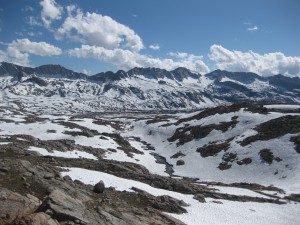 In The Mountains of California, John Muir writes of a day spent hiking in the High Sierras: “In so wild and beautiful a region was spent my first day, every sight and sound inspiring, leading one far out of himself, yet feeding and building up his individuality.” The naturalist aptly describes my own experience of the mountains, which inspire in me transcendent awe for nature, juxtaposed by a terrestrial understanding of my physicality.
In The Mountains of California, John Muir writes of a day spent hiking in the High Sierras: “In so wild and beautiful a region was spent my first day, every sight and sound inspiring, leading one far out of himself, yet feeding and building up his individuality.” The naturalist aptly describes my own experience of the mountains, which inspire in me transcendent awe for nature, juxtaposed by a terrestrial understanding of my physicality.
On this excursion, Matt and I entered Humph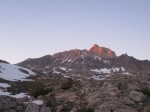 reys Basin by way of 11,400-foot Piute Pass. Due to this winter’s heavy snow season, the high peaks remained robed in white, and our trail frequently became a small stream of melted run-off. The basin appeared desolate and vast, with frozen lakes dotting the shadow cast by 14,000-foot Mt.
reys Basin by way of 11,400-foot Piute Pass. Due to this winter’s heavy snow season, the high peaks remained robed in white, and our trail frequently became a small stream of melted run-off. The basin appeared desolate and vast, with frozen lakes dotting the shadow cast by 14,000-foot Mt. 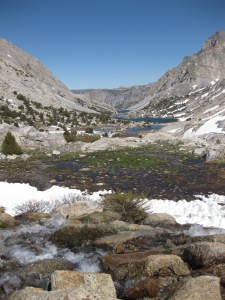 Humphreys. Signs of late-coming spring arrived in wildflowers and birdcalls; we could imagine the verdant meadow that soon would carpet the basin floor.
Humphreys. Signs of late-coming spring arrived in wildflowers and birdcalls; we could imagine the verdant meadow that soon would carpet the basin floor.
As on previous trips, Matt and I lamented that we have not yet brought friends or family with us to hike in the High Sierras. Our reticence to do so grows out of our awareness of the high country’s ruggedness and lack of low-elevation access points: the most spectacular scenery requires a several-thousand foot elevation gain to summit a 10,000+ foot pass, all while carrying a weighty pack.
While it is not impossible to complete a hike of this nature over the course of a weekend, a longer trip enables one’s body to acclimatize to the altitude and physical demands of the trail. When Matt and I hiked the 210-mile John Muir trail in the Sierras several years ago, we spent the first seven days of the hike in misery, nursing blisters, headaches, and spent muscles. We even briefly considered quitting the trail – it 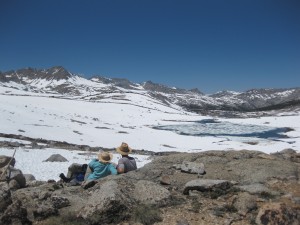 was just that hard.
was just that hard.
In time, however, we became more prepared for the physical and mental challenges of hiking the Sierras, and we came to appreciate our internal journeys, even as we reeled from the beauty that surrounded us. Matt and I now describe our hike on the JMT as one of the most transformative experiences of our lives, and we frequently recollect moments from that trip.
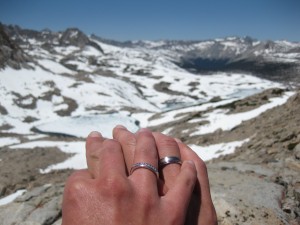 Given Matt’s and my love for the mountains, it is only appropriate that we began yet another journey in the Sierras this weekend. We hiked cross-country to the top of a ridge that overlooked a frozen cirque and the Lost Lakes. There, Matt asked me to marry him, and – in full knowledge of both my soaring potential and human frailty – I said yes.
Given Matt’s and my love for the mountains, it is only appropriate that we began yet another journey in the Sierras this weekend. We hiked cross-country to the top of a ridge that overlooked a frozen cirque and the Lost Lakes. There, Matt asked me to marry him, and – in full knowledge of both my soaring potential and human frailty – I said yes.
In many of the western towns I have visited, consumption and ownership of natural resources are among a locale’s most pressing issues. The West’s natural resources are used in diverse and profit-generating ways: locals speak of mining and the clean-up of old mines, logging, ranching and agricultural production, hunting and fishing, capturing the aesthetic value of land, harnessing alternative energy resources, and addressing water scarcity.
 Boise is by no means unique in its approach towards natural resources. Newly constructed homes march westward in files of yellow timber and green lawns. The city lies along the Boise River, which is dammed in multiple locations in order to provide irrigation and drinking water in a high desert climate (a debate is on-going as to whether an additional dam should be built). Meanwhile, business and community leaders speak hopefully of growth and of the recovering real estate market.
Boise is by no means unique in its approach towards natural resources. Newly constructed homes march westward in files of yellow timber and green lawns. The city lies along the Boise River, which is dammed in multiple locations in order to provide irrigation and drinking water in a high desert climate (a debate is on-going as to whether an additional dam should be built). Meanwhile, business and community leaders speak hopefully of growth and of the recovering real estate market.
But as I stand on a hillside overlooking the city, I experience one sudden and overwhelming thought: This is not going to work. Boise, among so many of our cities, is not on a consumption path that can be sustained into the future. Increasing numbers of the population cannot possibly occupy the consumption footprint of our predecessors; there’s simply not enough earth to go around.
In Collapse, professor and author Jared Diamond argues that many past human societies failed as a result  of their inability to address and prevent ecological collapse. From Norse Greenland to the Mayans, Diamond posits that contributing factors such as environmental damage, climate change, hostile neighbors, and a lack of friendly trade partners influence a civilization’s decline, but that a civilization’s response to environmental problems is the most significant factor in determining its success or failure.
of their inability to address and prevent ecological collapse. From Norse Greenland to the Mayans, Diamond posits that contributing factors such as environmental damage, climate change, hostile neighbors, and a lack of friendly trade partners influence a civilization’s decline, but that a civilization’s response to environmental problems is the most significant factor in determining its success or failure.
I believe in humanity’s ability to innovate our way out of problems. I do not believe that the world is going to self-destruct at some future point as a result of the environmental damage we have wrought. However, I do believe that the way in which we use and conserve our resources now will directly influence those that we have available to us in the future. I am awed by the lands I have seen and by the abundance those lands provide; I hope to be a voice in ensuring their continued fecundity and wildness.
